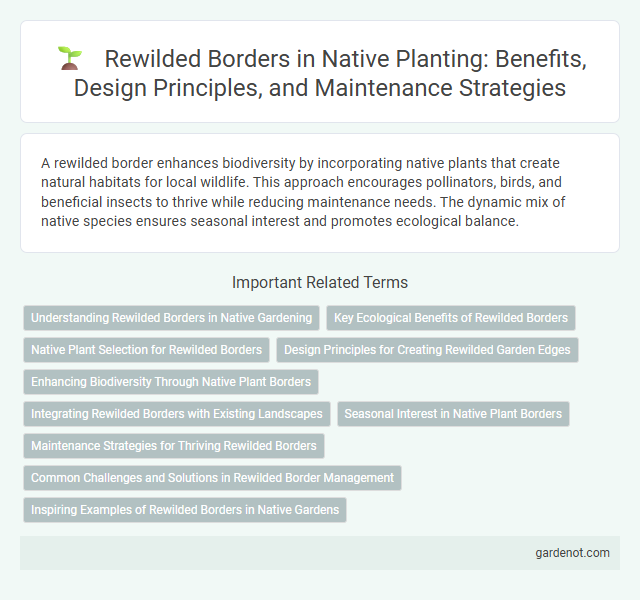A rewilded border enhances biodiversity by incorporating native plants that create natural habitats for local wildlife. This approach encourages pollinators, birds, and beneficial insects to thrive while reducing maintenance needs. The dynamic mix of native species ensures seasonal interest and promotes ecological balance.
Understanding Rewilded Borders in Native Gardening
Rewilded borders in native gardening promote biodiversity by allowing native plants to grow naturally without excessive human intervention, creating habitats for local wildlife and pollinators. These borders mimic natural ecosystems and support ecological balance by preserving native species and enhancing soil health. Incorporating rewilded borders helps restore native plant communities and strengthens ecosystem resilience against environmental changes.
Key Ecological Benefits of Rewilded Borders
Rewilded borders enhance biodiversity by providing essential habitats for native pollinators, birds, and beneficial insects, promoting ecosystem resilience. They improve soil health through organic matter accumulation and natural nutrient cycling, reducing erosion and runoff. These borders also contribute to carbon sequestration and support water filtration, playing a vital role in mitigating climate change impacts.
Native Plant Selection for Rewilded Borders
Selecting native plants for rewilded borders enhances biodiversity by providing essential habitats for local wildlife and pollinators. Species such as Echinacea purpurea, Asclepias tuberosa, and Solidago spp. thrive in rewilded borders, supporting ecosystem resilience and soil health. Incorporating locally adapted grasses and wildflowers ensures sustainable growth and reduces maintenance while promoting natural ecological balance.
Design Principles for Creating Rewilded Garden Edges
Rewilded garden edges thrive by incorporating native plants that enhance biodiversity and support local wildlife habitats. Using layered planting with structural diversity encourages natural growth patterns and resilient ecosystems, while minimizing human intervention fosters ecological balance. Selecting species adapted to local soil and climate conditions ensures sustainable, low-maintenance borders that blend seamlessly into the surrounding environment.
Enhancing Biodiversity Through Native Plant Borders
Rewilded borders using native plants create vital habitats that boost local biodiversity by supporting pollinators, birds, and beneficial insects. These plantings restore ecological balance, improve soil health, and foster resilience against pests and diseases. Native plant borders contribute to sustainable landscaping by promoting natural wildlife corridors and enhancing ecosystem services.
Integrating Rewilded Borders with Existing Landscapes
Rewilded borders enhance biodiversity by incorporating native plant species that support local wildlife and improve soil health. Integrating rewilded borders with existing landscapes requires selecting plants that complement current vegetation patterns and microclimates to create seamless transitions. Thoughtful layering of native grasses, wildflowers, and shrubs fosters ecological connectivity and resilience within urban and suburban environments.
Seasonal Interest in Native Plant Borders
Native plant borders designed for seasonal interest showcase vibrant color shifts, varied textures, and dynamic forms throughout the year. Rewilded borders use indigenous species like coneflower, black-eyed Susan, and switchgrass to provide habitat for pollinators while enhancing biodiversity. These native plants synchronize with local climate patterns, ensuring sustainable growth and continuous visual appeal from spring blooms to autumn seed heads.
Maintenance Strategies for Thriving Rewilded Borders
Regular selective pruning and removal of invasive species promote healthy growth in rewilded borders by reducing competition for native plants. Applying mulch conserves soil moisture and suppresses weeds while planting diverse native species enhances ecosystem resilience and attracts pollinators. Scheduling periodic monitoring during different seasons ensures early detection of issues and supports adaptive maintenance for long-term thriving borders.
Common Challenges and Solutions in Rewilded Border Management
Managing rewilded borders often involves challenges such as invasive species invasion, unmanaged growth impacting nearby native plants, and maintaining biodiversity balance. Implementing targeted invasive species removal, promoting native plant diversity through selective planting, and using adaptive management practices can enhance border resilience. Regular monitoring and community involvement also support effective long-term rewilded border health and ecological function.
Inspiring Examples of Rewilded Borders in Native Gardens
Rewilded borders in native gardens showcase a dynamic blend of indigenous plant species that promote biodiversity and support local wildlife, creating resilient ecosystems. Examples such as the Prairie Style borders in the Midwest or coastal wildflower strips in California demonstrate how strategic native planting restores habitat function and enhances pollinator activity. These inspiring designs emphasize seasonal variation and structural diversity, fostering sustainable landscapes that require minimal maintenance while maximizing ecological benefit.
Rewilded border Infographic

 gardenot.com
gardenot.com